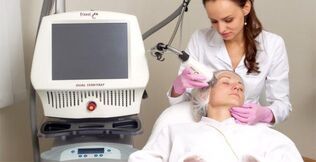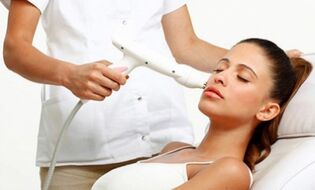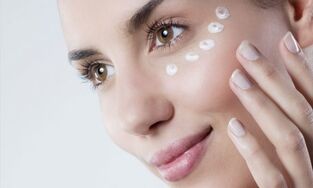Aging is a natural biological process that affects all tissues of the human body, including the tissue that makes up a person's outward appearance. At the same time, facial tissues are more prone to aging than others, because they are constantly under the influence of environmental factors, the functions of chewing, imitating and speaking. Since the face is a kind of "visiting card" for a person, the issue of maintaining and restoring youthful facial skin is very important and relevant. Among the many methods and techniques currently used to overcome this problem, laser facial rejuvenation requires special attention.
The essence of this method is the effect of laser beams on the skin. The laser stream is divided into many of the thinnest rays that affect the microscopic areas of the skin, which are located at a strictly defined depth, and vaporize them. The intact cells located between these areas stimulate the active production of collagen and elastin - the two main "building blocks, " which less and less build up in the human body as we age. After this procedure, the skin tone improves, the wrinkles are small and are being repaired, the bags under the eyes are removed and the oval face is tightened. At the same time, the rehabilitation period is reduced to a minimum. Fractional laser rejuvenation can be used not only as an independent method, but also to improve the results of plastic surgery or laser resurfacing of skin.

Laser is used for fractional laser rejuvenation
For the first time in the world, a patent for the fractional laser exposure principle was obtained in 2004 by the American company Palomar Medical Technologies. Fractional laser systems are currently represented by various laser technology companies. The most widespread are laser systems from Palomar and Fraxel, Affirm lasers from the well-known American company Cynosure, laser GentleYAG from Candela and others. Since all these arrangements have the same principle of action, the outcome of the procedure is largely determined by the professionalism of the specialists who carry out the procedure.
Contraindicated laser rejuvenation procedures
Absolute contraindications to this procedure are:
- Pregnancy, breastfeeding.
- Focus the inflammatory process in the affected area.
- Psoriasis and dermatosis.
- Focus herpes infection on the affected area.
- Chemical peeling of the intended treatment area less than two weeks before the procedure.
- Oncological disease.
- Systemic diseases of the blood, immune system, connective tissue.
- Diabetes mellitus is in the decompensation stage.
- Severe forms of hypertension and coronary heart disease.
- Varicose veins in the procedure area.
- Tendency to form keloid scars.
- Family history of vitiligo.
Relative contraindications include active sun exposure in the last three weeks prior to the procedure, namely the presence of new sunburn, as well as surface and midline peels performed on the treatment area less than three weeks prior to the procedure.
Benefits of Fractional Laser Rejuvenation
Thanks to the spot effect, skin damage is minimal, so all traces after the procedure disappear in 3-4 days.
This method allows you to treat large areas of skin in a single procedure, while maintaining and activating the skin's regenerative resources, providing fast rehabilitation and long-term growth with positive effects.
This procedure does not require anesthesia, can be performed on the neck, décolleté and eye area.
Side effects are rare. Possible complications include temporary appearance of red-purple spots on the treatment area, mild and fleeting itching, activation of herpes infections, changes in skin texture, including burns, peeling, and crusting. Scarring, hyper- and hypopigmentation of the skin in the area of the procedure are very rare, but can be permanent.
What is the complete laser rejuvenation procedure
One fractional laser exposure session lasts 20-40 minutes, depending on the nature of the problem and the area being treated. Repeated procedures are carried out in 3-4 weeks. As a rule, it takes 3-4 sessions in total. The maximum positive effect occurs within three months after the last procedure. It is advisable to carry out a treatment session every 10-14 months.

What to do after the laser facial rejuvenation procedure
A slight burning sensation that may be felt after the procedure goes away within 1-2 hours, while redness and slight swelling can last for 1-3 days. During this period, external agents (creams, ointments, sprays) containing dexpanthenol should be used, for example, Bepanten, Panthenol, D-Panthenol. After the disappearance of the registered symptoms and before the next procedure, a cream with hyaluronic acid is applied.
You can bathe and shower on the day of the procedure, but it is better to wait in the sauna and swimming pool. The foundation can be used the day after the procedure.
Sunscreen must be used with a protection factor of at least 30, as this is when the skin's metabolism is activated, and it becomes very sensitive to sunlight.
After the procedure, it is necessary to follow the recommendations of the specialist who carried out the procedure. The choice of cosmetic products, their frequency and duration of use are determined individually and depending on the type of skin and its characteristics.
Fractional laser rejuvenation is a cosmetic procedure when the skin is exposed to a laser circuit made of microbeam. The purpose of this effect is to activate the regeneration and collagenogenesis processes. This is a relatively new, but already very popular, hardware technique. In another way, it is called a fraxel, fractional laser resurfacing or photothermolysis.
Principles of operation and types of fractional laser rejuvenation
How do fractional lasers work? The micro-rays emitted by the equipment cause heat shock, in response to "lazy" skin cells starting to function more actively. To repair damaged areas, they divide faster. Old cells that turned out to be inoperable die, giving way to young cells. The heating of the deep layers of the skin is accompanied by partial denaturation of proteins, as well as the formation of new components of the extracellular matrix, including elastin and collagen.
According to the depth of impact, ablative and non-ablative laser rejuvenation is distinguished. The first is shallow and resembles a grinder. Laser treatment of the top layer of the skin is accompanied by evaporation of moisture, damaging the epidermis. After healing, the skin becomes firmer, is relieved and the color is evened. During non-ablative photothermolysis, the laser affects the deep layers of the skin. In this case, no open wound is formed.
Each type of refresh has its advantages and minutes. Thus, the ablative laser resurfacing effect is seen after the first procedure. With this method, you can get rid of deep wrinkles and age spots, acne, stretch marks, scars. With non-ablative procedures, there is no risk of infection, and the anti-aging effect is seen for several years. This type of photothermolysis is recommended for people under the age of 40 with the first signs of aging: fine wrinkles, reduced turgor.
Indications and contraindications for the procedure
A photothermolysis procedure is appropriate if one is available:
- Looseness, sagging skin.
- Fine and deep wrinkles, wrinkles.
- Pigmentation of all origins.
- Increased sebum secretion.
- Enlarged pores, easy acne.
- Scars, stretch marks, post acne.
- vascular "star" (couperosis).
- Dull skin.
Contraindications for fractional laser rejuvenation are:
- Allergies, psoriasis.
- Autoimmune disease.
- Pregnancy, breastfeeding.
- Blood disease.
- Skin infection, inflammation of the area to be treated.
- All chronic diseases are in the decompensation stage.
- Oncology.
- Increased body temperature.
- Diabetes mellitus.
- Tendency to form keloid scars.
- Epilepsy.
Laser rejuvenation feature
Preparation for the fractional photothermolysis procedure is to refuse to visit the solarium and the beach for two weeks. So far, it is also impossible to clean the skin, do chemical peels, drink sulfonamides, fluoroquinolones, tetracyclines. Three days before the procedure, they stopped going to swimming pools, baths, saunas, treating areas that were suspected of being exposed to cosmetics containing alcohol. To prevent complications, the cosmetologist can prescribe antiviral and antibacterial drugs for this period. The day on the night the procedure should be carried out without alcohol and cigarettes, do not go to the gym.
Prior to laser treatment, the skin was cleaned of cosmetics and impurities. In general, the laser effect is felt as an unpleasant tingling sensation, but pain relief is sometimes needed. In this case, the beautician will anesthetize the prepared skin area. After the ointment worked, she began treating the skin with lasers. The duration of the procedure depends on the size of the treatment area and ranges from a few minutes to an hour. Lastly, the skin is soothed with a nourishing cream.
The first days after the procedure, you should not use alcohol-based products, compress the part of the body where the photothermolysis is carried out, with compression linen. It is advisable to exclude physical activity for a week, visit the pool, sauna or bath, limit the time spent on the road. The skin is moisturized with a special cream three times a day. And for half a month. It is undesirable to peel, use cosmetics with retinol, salicylic acid. For two months it is necessary to use a cream with a sun protection factor of 35 or more.
How many procedures do you need to achieve results? What effects can you expect?
The rehabilitation period after laser fractional rejuvenation lasts from 3 to 7 days. Recovery speed is very dependent on lifestyle. Alcohol consumption, smoking, excessive activity, unbalanced diet, insomnia and anxiety can slow down the regeneration process.
During the first three days after laser exposure, redness and slight swelling may occur. Anesthetics and skin cooling can help reduce discomfort. Naturally, if the skin feels tight in a week, there are scaly areas. A side effect of this procedure is a reddish brown color, which will go away on its own after half a month.
Persistent results after fractional photothermolysis occur after 2-5 procedures. More specifically, the number of sessions can only be determined by a cosmetologist, based on preliminary data. The interval between procedures is 3-4 weeks. As a result of fractional laser rejuvenation, the aging process is inhibited: wrinkles disappear or become less visible, turgor increases, pore severity decreases, and skin tone improves. This method is an effective tool in fighting scars, pigmentation, acne scars, stretch marks.
Laser fracture rejuvenation is one of the three most popular hardware cosmetic procedures. The advantages include efficiency, short healing period, physiology. The results are visible after the first procedure and last up to three years. This method has various indications. It is possible to choose the depth of laser exposure.
A woman of all ages wants to see beautiful skin in the mirror, but not everyone is ready for plastic surgery.
In this regard, fractional rejuvenation through the use of lasers will help, which in modern cosmetology takes one of the first places in anti-aging procedures.
Exposure type and method
Ablative photothermolysis
There are two methods of photothermolysis, each suitable for different cases. The right choice for choosing the best will help the cosmetologist to make the first appointment.
This method is suitable for rejuvenating skin that is just beginning to experience natural aging.
Laser assisted microdamage tissue affects only the top layer of the epidermis, forcing it to regenerate in no time.
Results appear after the first procedure, as soon as the wound has healed.
Non-ablative photothermolysis
This method is a slightly more serious intervention. Laser light penetrates into the inner layers of the epidermis, ignoring cells on the outside.
Breakdown also promotes the production of elastin and collagen, as in ablative photothermolysis.
The healing process takes longer and the effect is more pronounced. Suitable for removing serious facial problems.
Reading
Anyone looking to recover without serious braces can use this method.
Fractional laser treatment fights many imperfections on the face, including:
- a very prominent frown on the forehead;
- nasolabial folds;
- thread of crow's leg around the eye;
- epidermis, "flows downward";
- skin pigmentation, scars, scars, spider veins;
- problems with enlarged pores, acne.
Laser therapy has proven to be very effective in eliminating all of these problems.
The only caveat is that depending on the severity of the imperfection, multiple procedures may be required.
Contraindications
Like other external influences on the body, fractional laser rejuvenation has its own contraindications, for which such procedures are prohibited.
This includes:
- severe inflammation of the face;
- fungal infection of the skin;
- diseases of the epidermis - psoriasis, eczema;
- excessive dryness of the skin;
- malignant neoplasm in the body;
- history of epilepsy;
- heart disease;
- varicose veins on the face;
- herpes in the acute stage;
- pregnancy, breastfeeding;
- immunodeficiency status;
- bronchial asthma, serious allergic reactions;
- neurological disease.
All contraindications are conditional, that is, the beautician takes into account all the risks of the patient.
Sometimes you should first undergo treatment for skin problems or wait for chronic disease remission, after which rejuvenation continues.
Getting Started
Since intervention is not a surgical operation, no serious preparation is required. Initially, you should consult a cosmetologist who will assess the condition of the skin, and will also provide recommendations for the necessary photorejuvenation methods.
Patients are required to inform the doctor about all conditions and diseases in the history, as well as about any exacerbations of chronic diseases during the past six months.
If available, the specialist will advise you to visit a specialist to assess the safety of the procedure.
You should also do blood and urine tests to identify or exclude inflammatory processes in the body. Then the date of the first visit is set.
Execute
Fractional laser skin rejuvenation in the facial area is performed on an outpatient basis, ie the patient is admitted, treated, and then discharged.

The cosmetologist will first apply an anesthetic cream or ointment based on lidocaine to the epidermis.
In fact, this procedure is not very painful, so sometimes therapy is done without going through this step.
Be aware that the use of local anesthetics slightly hinders the skin's natural regeneration afterward.
Then the patient lies on the sofa, and the specialist adjusts the depth of penetration of the laser beam on the special device. This device is aimed at a specific area of the epidermis, deep into the laser penetration.
The manipulation takes from half an hour and more, depending on the area to be handled with the device. During the procedure, the patient may feel a slight tingling sensation, as well as an unpleasant odor.
As soon as the session is over, a line of red dots is visible on the face, the skin is red, slightly swollen, so it is better to be careful on the way home first.
Possible complications
Fraction rejuvenation doesn't get rid of complications. In some cases, they are normal and disappear within a few days.
Others developed due to a lack of experience from a cosmetologist or a lack of proper facial care during the rehabilitation period.
What is not the norm:
- severe pain or swelling where the laser beam is exposed;
- the lesion did not heal in two weeks;
- pigmentation and scars appear.
Mild, scaly redness and itching are predictable conditions for all types of epidermis.
Such consequences go away on their own in 1-2 weeks, leaving no visual imperfections.
Rehabilitation
The outcome of this procedure is strongly influenced by the patient's own behavior. He should carefully monitor the skin, protect it from aggressive environmental influences, and not use decorative cosmetics during healing.

General guidelines:
- The first three days of the wound should be lubricated with an ointment based on dexpanthenol,this will accelerate the healing of micro-damage. Furthermore, it is recommended to use a light moisturizer with hyaluronic acid, which is recommended by beauticians.
- Washing is not prohibited.For 2 weeks, the epidermis should not be exposed to strong heat, so it is better to stop bathing and sauna, do not take hot baths.
- You shouldn't go outside without sunscreen,and prefer protection from 50. If this is not done, hyperpigmentation will occur. Cosmetic products should be applied until complete healing, even if it is winter outside.
After a few weeks, it is advisable to revisit the specialist who performs fractional laser rejuvenation. He must assess the condition of the skin on the face, rule out complications.
Approx
The result can be seen immediately after healing, if the imperfections are minor. Deep wrinkles or scars should be removed with some treatment.
Visually, the skin is smoother, has a natural tone, the face is toned and looks blooming in 99% of cases.
One percent is devoted to unforeseen circumstances, inadequate care, and lack of medical qualifications.
Method advantages
For many patients, this method wins out with significant advantages worth noting. By choosing photothermolysis, one accepts the following:
- low cost with high efficiency;
- doesn't hurt;
- the effect of even a single procedure;
- non-invasive;
- lack of strong side effects.
Also, the laser effect solves several problems of the epidermal aesthetic component at once, which is good news.
Disadvantages
If you choose the wrong clinic for rejuvenation or don't strictly follow the beautician's recommendations, you can get large age spots on half of your face, which won't be easy to get rid of.
In addition, the laser treatment lasts a long time, during which the patient feels an unpleasant odor from the damaged skin, which no one can tolerate.
Another disadvantage is the incomplete result of a single procedure for deep depressions, scars and wrinkles.
Reviews opinions
Fractional rejuvenation is gaining popularity in make-up. Every year more and more women are choosing lasers over scalpels.














































































